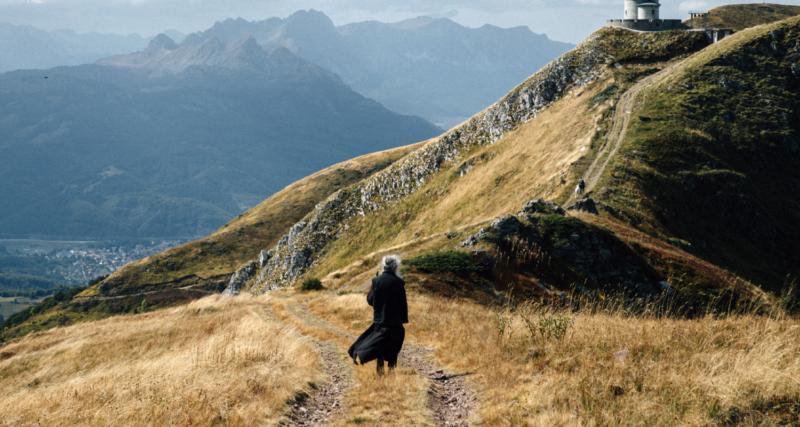
Monk ascending a mountain to pray
The Middle Ages were arguably the golden years for Christian pilgrimage in Europe. Christianity was at the center of the western world in both political and religious terms. The roads of Western Europe were trod by countless pilgrims traveling to sites such as Rome to visit the relics of Saints Peter and Paul, to Santiago de Compostela to visit the tomb of St. James, to Loreto, Walsingham, Monte Sant’ Angelo, and to countless other places. The people were eager for direct contact with holiness and for Divine intercession in their lives. This desire was fulfilled by visiting the holy sites, and by praying for forgiveness, grace and miracles in the presence of the saints’ relics. The relics carried back from the Holy Land by the Crusaders enlivened the spiritual ambiance of many churches and created vortices of power and prayer. Many roads were built, and inns and churches erected, to accommodate the multitudes traversing the continent in search of inner peace and a touch of sanctity.
This trend continued until the advent of the Reformation at the end of the fifteenth century. With Martin Luther’s separation from the Roman Catholic Church and the beginning of the Protestant movement, many people began to look anew at the practices of the Church. Many Protestants held the act of pilgrimage as useless and felt the worship of saints was misguided. Their misunderstanding of the heart-felt devotion of many true pilgrims dampened the pilgrim spirit for years and placed a negative connotation on sacred travel. The ancient tradition was again bolstered by the Catholic Counter-Reformation of the sixteenth century, although the numbers of pilgrims never again approached those of the Middle Ages.
The beginning of the industrial revolution and the age of scientific thought produced another low ebb in spirituality, and it took Divine intervention to awaken those with spiritual inclinations. Many highly publicized apparitions of the Blessed Virgin Mary occurred in the mid-nineteenth century, raising the spiritual consciousness of the masses and starting a new flood of pilgrims to these “modern” holy sites. Blessed Mary’s appearance in France at Rue de Bac in 1830, La Salette in 1846, at Lourdes in 1858 and Pontmain in 1871, sparked a renewed interest in pilgrimage. After the turn of the twentieth century, the apparitions of the Blessed Virgin Mary spread to other countries, at Fatima, Banneau, Beauraing, and later, Medjugorje, inspiring many people to visit new lands and discover the depths of the pilgrimage experience.
Now, in the twenty-first century, this quest for a personal experience of the Divine continues to magnetically attract people of all religions and beliefs. Pilgrimage was enjoying an all-time high in the latter part of the twentieth century until the terrorist attacks of September 11th, 2001, when the world of travel was abruptly derailed. This created only a temporary barrier for pilgrims traveling to other lands, for pilgrimage will always be a source of inspiration as it has been since the dawn of spiritual aspiration. Whenever world events disrupt the flow of international travel, for a time pilgrimage may be more of the heart than of the body, but the longing for God continues uninterrupted. Whether we travel to a sacred site or stay home and read about a saint, our prayers and focused meditations are the most important aspect of inner pilgrimage. The true essence of pilgrimage is always centered at home in one’s own heart.
When God spoke to St. Catherine of Siena as recorded in her Dialogue, He said, “The eye cannot see, not the tongue tell, nor can the heart imagine how many paths and methods I have, solely for love and to lead them back to grace so that my truth may be realized in them!” God, the Father, Mother Divine, offers us many paths to satisfy our inner yearning for spiritual wholeness, but it is up to each of us to seek out that infinite source of love, embrace it as our own, and awaken the saint within.
Excerpt from Heater, James and Colleen. The Pilgrim’s Italy: A Travel Guide to the Saints. (Inner Travel Books: Nevada City, California), 2008. pages 21-23.








Leave A Comment
You must be logged in to post a comment.